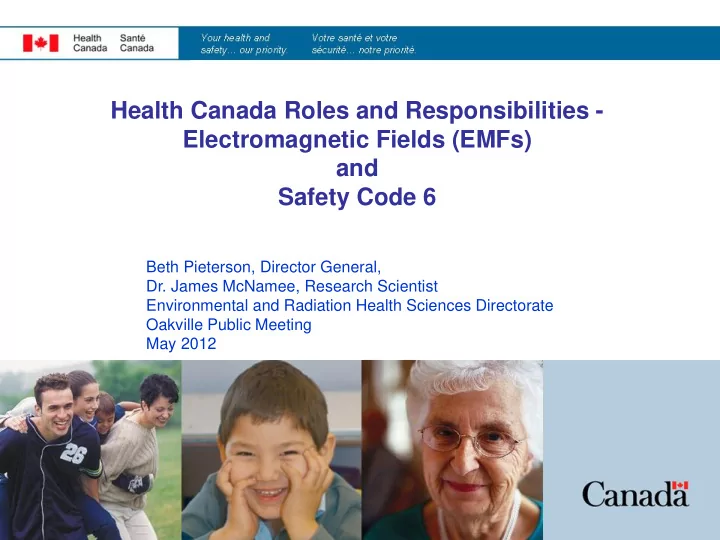

Health Canada Roles and Responsibilities - Electromagnetic Fields (EMFs) and Safety Code 6 Beth Pieterson, Director General, Dr. James McNamee, Research Scientist Environmental and Radiation Health Sciences Directorate Oakville Public Meeting May 2012
The Electromagnetic Spectrum • The electromagnetic spectrum is the range of all possible frequencies of electromagnetic radiation 2
Health Canada Responsibilities • Health Canada develops human exposure limits for the protection of the general public, and workers, from EMF (Safety Code 6); conducts laboratory studies, monitors and reviews external research on the potential health effects associated with exposure to EMFs; and advises government departments and agencies, including Industry Canada, industry, and the general public on health aspects regarding EMF exposure. 3
Health Canada’s RF exposure guidelines - Safety Code 6 (2009) 4
Safety Code 6 Limits of Human Exposure to Radiofrequency Electromagnetic Energy in the Frequency Range from 3 kHz to 300 GHz • One of a series of documents to set out practices for radiation protection from radiation emitting devices. • First published in 1979. Revised in 1991, 1999 and 2009. Next review is currently underway and scheduled for completion in early 2013. • Establishes safety limits for human exposure to radiofrequency (RF) electromagnetic energy in the frequency range from 3 kHz to 300 GHz. • Adopted by Industry Canada for radiocommunication licensing and operational requirements. • The current version of the Code is accompanied by the Technical Guide for Interpretation and Compliance Assessment of RF Exposure Guidelines . • Electronic copies available upon request (contact: publications@hc-sc.gc.ca). 5
How was Safety Code 6 developed? • Health Canada scientists have evaluated the results of scientific studies conducted over the past 50 years on the possible health effects of RF energy. All peer-reviewed scientific studies were considered. Studies were assessed for their scientific quality and a weight-of-evidence approach was used when evaluating the data. Thresholds for adverse health effects in humans were identified - a 50-fold safety margin was incorporated into the public exposure limits, affording levels of protection sufficient for children and the most vulnerable. An expert committee of the Royal Society of Canada provides external expert advice on the limits recommended in Safety Code 6. Results of current and future reviews are made available on the HC website. 6
Safety Code 6 Limits Establishment – Thermal and Non-thermal Effects • Exposure limits in Safety Code 6 (2009) are based on all biological effects, whether related to heating of the tissue (thermal) or exposure levels too low to cause significant tissue heating (non-thermal). • The view that exposure limits specified in Safety Code 6 are based entirely on thermal effects is incorrect. • For the lower frequency range, from 3 kHz to 100 kHz, the biological end point on which the limits are based is nerve and muscle stimulation. Although these are acute effects, they are non-thermal in nature. • At higher frequencies, non-thermal effects are not well established and currently do not form a scientifically acceptable basis for restricting human exposure to RF energy. • Safety Code 6 limits are considered to be well below the threshold for any potential harm. Canada 7
What about the IARC classification of RF energy as “possibly carcinogenic to humans”? • In 2011, the International Agency for Research on Cancer (IARC) classified RF energy as “possibly carcinogenic to humans” (Class 2B). A Health Canada scientist participated in the IARC review that led to the classification. • The IARC classification reflects the fact that limited evidence exists that RF energy might be a risk factor for cancer. • The vast majority of scientific research to date does not support a link between RF energy exposure and human cancers. • Much of the data used to support the IARC Class 2B designation came from studies of brain cancer incidence in long-term/heavy cell phone users. • At present, the evidence of a possible link between RF energy exposure and cancer risk is far from conclusive and more research is needed to clarify this “possible” link. • Health Canada is in agreement with both the World Health Organization (WHO) and the IARC that additional research examining long-term, heavy use of cell phones is warranted. 8
IARC and RF Exposure: Cell Phones vs. Cell Towers • Health Canada, as a precaution, recently updated its advice pertaining only to cell phone use but not to RF energy exposures from cell towers or other wireless devices. • Intensity and distribution of RF energy absorbed within the body from cell towers are very different from that of cell phones. • Unlike exposures from cell phones, where relatively high RF energy levels occur in a localized area of the head, RF energy exposure from cell towers is not localized to one part of the body, but rather absorbed at very low levels across the entire body (much like exposure to AM/FM radio signals). • The Department does not consider additional precautionary measures for other wireless devices, such as cell phone towers and WiFi equipment, to be warranted. Canada 9
Conclusion EMFs: • cannot be perceived by any of the human senses (i.e. are invisible, colorless and odorless); • diminish greatly with distance from the source; and • are non-ionizing (do not have enough energy to break chemical bonds) in matter (i.e. cannot damage your body's genetic material like X-rays). Health Canada and the international scientific community are in agreement that EMF from cell towers does not pose a risk to human health. Canada 10
Looking for Additional Information? • For more information on Cell Phone Towers, please visit the Health Canada webpage It’s Your Health at: http://www.hc-sc.gc.ca/hl-vs/alt_formats/pacrb-dgapcr/pdf/iyh- vsv/prod/cell-eng.pdf • For further information, please visit the Health Canada Environmental and Workplace Health webpage at: http://www.hc-sc.gc.ca/ewh-semt/radiation/cons/stations/index- eng.php 11
Recommend
More recommend